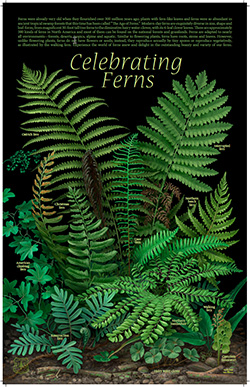Posters
Enjoy these posters featuring the Celebrating Wildflowers program and related themes on our National Grasslands and Forests.
Celebrating Wildflowers
Celebrating Wildflowers is dedicated to the enjoyment of the thousands of wildflowers growing on our national forests and grasslands, and to educating the public about the many values of native plants.
Artist: Steve Buchanan
Celebrating Wildflowers - Ethnobotany...plants sustaining people
Plants give us food, drink, shelter, medicine, fiber, dyes, waxes, essential oils, perfumes, and the air we breathe. Countless people before us tested and kept plants that were useful. Our cultures evolved by passing ever more sophisticated knowledge of plants along from generation to generation. Even in this age, we depend on plants and their pollinators for our existence and survival.
Artist: Steve Buchanan
Celebrating Ferns
Ferns were already very old when they flourished over 300 million years ago. Plants with fern-like leaves and ferns were so abundant in ancient tropical swamp forests that this time has been called “The Age of Ferns.” Modern-day ferns are exquisitely diverse in size, shape and leaf-form; from magnificent 30-foot tall tree ferns to the diminutive hairy water-clover, with its 4-leaf clover leaves. There are approximately 380 kinds of ferns in North America and most of them can be found on the national forests and grasslands. Ferns are adapted to nearly all environments - forests, deserts, tropics, alpine and aquatic. Similar to flowering plants, ferns have roots, stems and leaves. However, unlike flowering plants, ferns do not have flowers or seeds; instead, they reproduce sexually by tiny spores or reproduce vegetatively, as illustrated by the walking fern. Experience the world of ferns anew and delight in the outstanding beauty and variety of our ferns.
Artist: Steve Buchanan
Celebrating Our National Grasslands, Prairies, and Wildflowers
"A world of grasses and flowers stretched around me, rising and falling in gentle undulation. Acres of wildflowers of every hue glowed around me. What a new and wondrous world of beauty! What a magnificent sight! I was in the midst of a prairie!"
Eliza R. Steele, A Summer Journey in the West 1841
Artist: Steve Buchanan
Celebrating Our Native Grasses
Developed for the U.S. Forest Service, Bureau of Land Management, and the Plant Conservation Alliance, this poster showcases native grasses found on our nation's public lands.
Artist: Steve Buchanan
Klamath-Siskiyou Serpentines
The Klamath-Siskiyou Mountains of northwest California and southwest Oregon are the largest serpentine area in North America. Celebrating Wildflowers features the unique serpentine plant communities on the National Forests of the Klamath-Siskiyou Mountains with this colorful poster.
Artist: Steve Buchanan
Tall Forb Community of the Intermountain West
The Western narrative is one of spellbinding landscapes - a place of immense skies and majestic mountains where rivers arise and nourish the dry valleys below, a land of dreams and unfettered imagination. Nowhere is this more magnificent than in the subalpine parklands where remnant tall forb wildflower fields are strewn among the high plateaus and peaks of the Intermountain West.
Artist: Steve Buchanan
The Pollinator Partnership
Join the Conversation about Native Bees
North America has over 4.400 described species of native bees that pollinate wildflowers and crops. Explore and learn about the pollinators on the Native Bees poster, available from the Pollinator Partnership website…
Bumblebees of the Eastern United States

Twenty-one species of bumble bees (Bombus spp.) occur east of the 100th meridian. This poster made available by the Pollinator Partnership, depicts the bumble bee species occurring east of the Mississippi River in the United States.
Art and Design: Steve Buchanan
Download Print Size Version (PDF, 68.5 MB)
Download Reduced Size Version (PDF, 1.4 MB)
Bumblebees of the Western United States

Bumble bees (Bombus spp.) are vitally important pollinators of wild and managed flowering plants. In the contiguous United States 30 species of bumble bee are found west of the Rocky Mountains. This poster made available by the Pollinator Partnership, depicts the bumble bee species occurring west of the Mississippi River in the United States.
Art and Design: Steve Buchanan
Download Print Size Version (PDF, 16.1 MB)
Download Reduced Size Version (PDF, 4.4 MB)
North American Pollinator Protection Campaign

"Our Future Flies on the Wings of Pollinators"
This poster is made available by the U.S. Forest Service, U.S. Fish and Wildlife Service, Bureau of Land Management, Natural Resources Conservation Service, U.S. Botanical Gardens, and the NAPPC (North American Pollinator Protection Campaign).
Artist: Paul Mirocha
The Bounty of Bees
"Our Future Flies on the Wings of Pollinators"
This poster features important bee species and the important plants they help pollinate, made available by the Pollinator Partnership; USDA Natural Resources Conservation Service, CSREES, and U.S. Forest Service; North American Pollinator Protection Campaign; USDI Bureau of Land Management, U.S. Fish and Wildlife Service, National Park Service, and USGS; Plant Conservation Alliance; Wildlife Habitat Council; Burt's Bees; The National Gardening Association; and, the United States Botanic Garden.
Artist: Steve Buchanan











